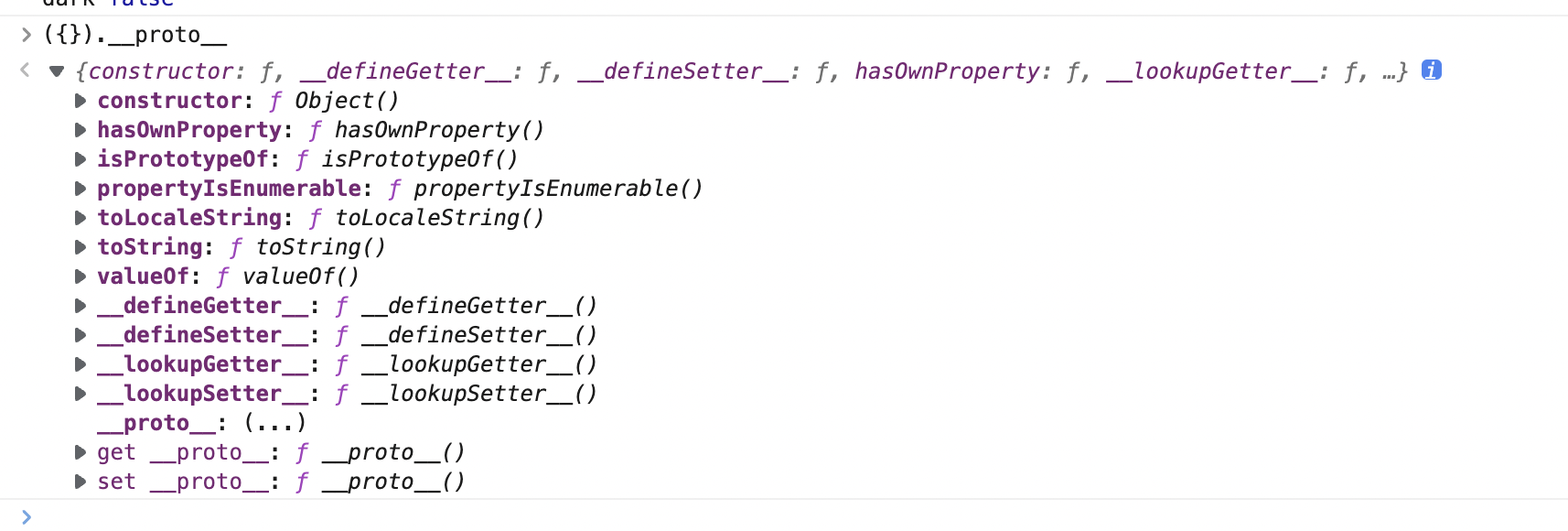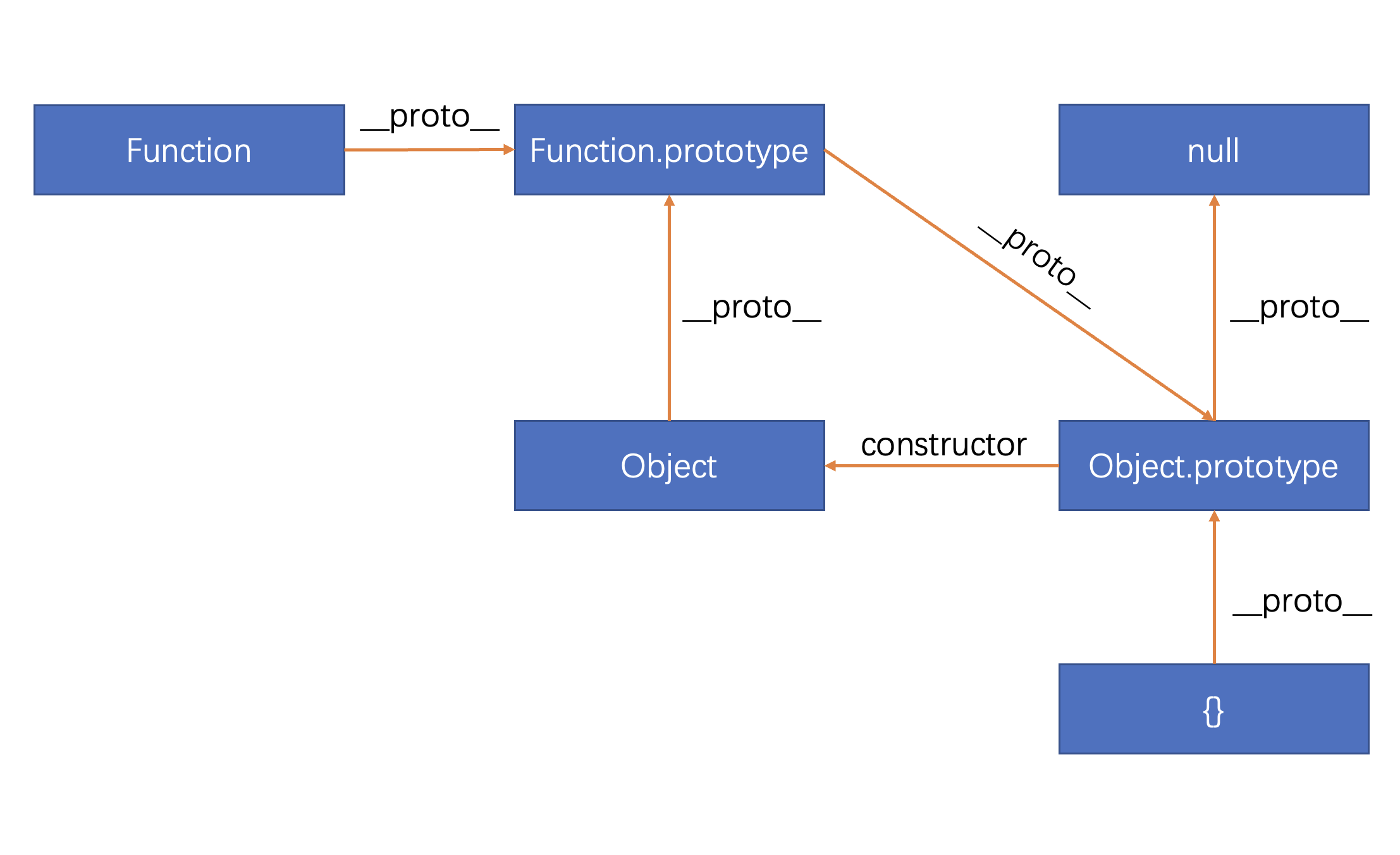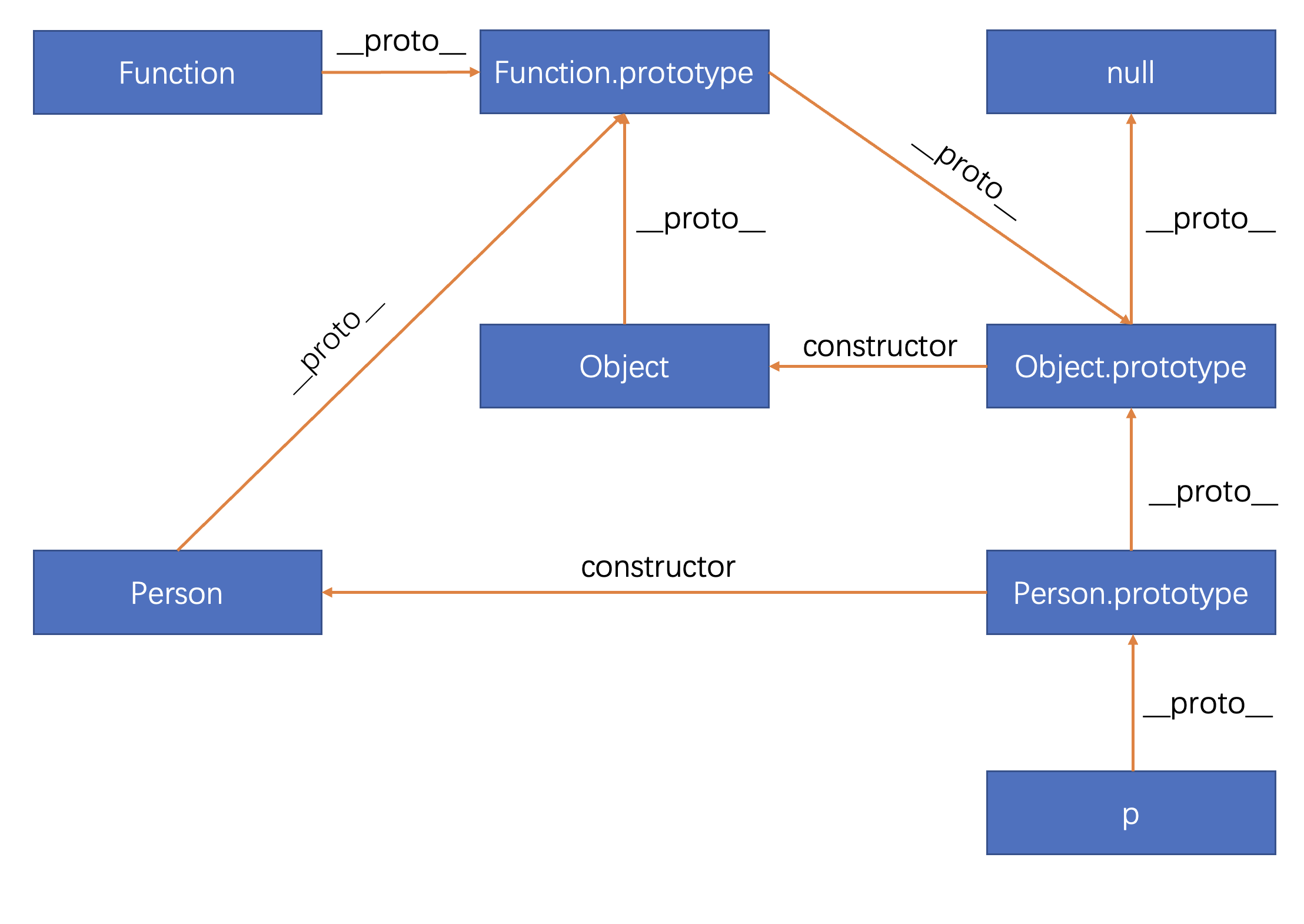# 原型及原型链
JS是一门基于原型继承的语言,并不是传统的Java,C#基于类继承的语言,这是JS较为重要的一个特征之一。
虽然ES6增加了class的语法,然而class的本质还是基于原型及原型链的关系,是个语法糖而已,因此对于任何一个前端来说这个知识点是必须要掌握的。
# __proto__ 和 prototype
之前我在论坛上听大家有叫__proto__什么隐式原型对象的,我个人感觉叫什么不重要,只要你理解它能干啥就行了(就好比你说话,如果别人都能听懂了,你还去纠结什么是主语什么是谓语什么是宾语就有点儿孔乙己了),所以我一直从初学到现在任意大中小厂面试只要提到原型链我都是直接念的__proto__。
# __proto__
为什么说JS万物皆对象呢,我想大概就是因为它吧。
已知的除了null,undefined,ø(即Object.create(null))没有这个属性以外,所有的变量都会有__proto__。为什么一个空对象({})能够拥有toString方法呢,因为({}).__proto__指向的是Object.prototype。
JS属性的一个读取特征就是,首先它会在当前的对象上找,如果找的到的话,直接就使用,找不到就通过__proto__到它的原型对象上去找,如果还找不到,就到原型对象的原型对象上去找,如果原型对象的原型对象不存在呢?不存在的话就报错了,如:a.demo is not a function。
所以,任意的数据类型的实例都指向它的原型对象,因此有:
(1).__proto__ === Number.prototype;
// 注意:NaN也是number类型
true.__proto__ === Boolean.prototype;
({}.__proto__ === Object.prototype);
Symbol(1).__proto__ === Symbol.prototype;
"hello world".__proto__ === String.prototype;
(() => {}).__proto__ === Function.prototype;
# prototype
这个属性是找原型对象的钥匙,也就是说,我们要获取到一个原型对象,必须得通过prototype,我的理解就是原型对象它是放在仓库的一个工具箱,要想使用这个工具箱,首先得找仓库(即找对应的构造器),找到仓库之后,拿钥匙开门(即prototype),然后我们就可以打开这个工具箱,发现这里面有好多工具可以用。

但是问题就是,不是随便一个阿猫阿狗都能拥有prototype这个属性的,想要拥有这个属性,这个对象必须是一个构造器(constructor)
现在我们用一个生活中的例子来捋一捋刚才所讲的知识点之间的关系:
印度尼西亚想向中国订购一列高铁(对象的实例,即instance),那么,中国中车是造高铁的工厂(构造器),高铁不是生产出来就完了,还需要有一系列维护运营的技术(即原型对象上的方法),生产的高铁上贴着标签: 中国中车制造(__proto__),那么以后这列高铁的维护运营都可以使用中国中车提供的技术了。

有一个问题就是,虽然这些高铁技术是中国中车的,但是这些技术放在那儿,但我们总感觉会被西方反华势力剽窃走,所以,我们最好希望让这些技术的专业技术人员们知道自己是归属于谁的,因此原型对象上有一个constructor属性是指向构造器的,如:
Object.prototype.constructor === Object; // true
有了这个例子之后,我们可以很容易的分清楚构造器和原型对象的关系了,如Object和Object.prototype。
# 获取或修改原型的指向关系
Object.setPrototypeOf和Object.getPrototypeOf
# 函数与构造器
# 函数
上一节中,我们强调了在JS中万物皆对象,函数也是一类特殊的对象。
我们定义一个函数,就生成了一个函数的实例,如:
function Person() {}
根据上文阐述的内容得知,函数的实例指向的是函数的原型对象,即:
Person.__proto__ === Function.prototype; // true
Person.prototype.constructor === Person; // true
JS的函数除了普通的调用方式以外,还可以通过new调用以生成对象,但是通过new调用是有条件的,这个函数必须拥有prototype属性(从逻辑上讲,这样用当前函数创建对象之后才能知道是哪个工厂生产的呀),有prototype才会有constructor,而这个构造器又指向的是它自己,所以有无prototype就成为了这个函数是否能通过new调用的先决条件了。
# 构造器
刚才我们阐述原型对象的过程中有一个非常关键的概念还没有详细阐述,那就是constructor(基于上文所述,此处阐述的构造器譬如Object.prototype.constructor,简化描述为Object),通过第一节的分析,它跟原型对象,存在一定的关系,但是肯定不是一个东西,(最开始我们只阐述了3个没有原型对象的类型),那它指向的是谁呢?答案是函数原型对象(Function.prototype)。
任意一个构造器都是函数原型对象的实例,即:
Object.__proto__ === Function.prototype; // true
Number.__proto__ === Function.prototype; // true
Boolean.__proto__ === Function.prototype; // true
String.__proto__ === Function.prototype; // true
Symbol.__proto__ === Function.prototype; // true
Array.__proto__ === Function.prototype; // true
上面还有一个关键的指向关系没有阐述,容我卖个关子。
我们已经得出结论,任意一个构造器都是函数原型对象的实例,请问Function是构造器吗?
毫无疑问必须得是啊,既然是,那就应该符合我们这个结论,即:
Function.__proto__ === Function.prototype; // true
曾经很长一段时间,我都是把这个指向关系当结论给记住的,其实经过上述的一通分析,完全没有必要死记硬背啦。
所以,我们就可以画出一个比较全面的指向关系:

再来个更复杂一点儿的,加一个自定义的函数试试:
function Person() {}
Person.prototype.getName = function () {
return "JohnYang";
};
let p = new Person();
把Person和p加到我们刚才的图中去,得到的关系如下:

DANGER
箭头函数是一类特殊的函数,其没有prototype,导致其不存在constructor,因此不能通过new调用。
打个比方,箭头函数就好像是一只做了绝育手术的猫。
# ES6类继承中的原型链指向关系
本文不阐述class的语法,如果还不了解的朋友可以先行查阅相关资料。
假设现在有如下两个类,并且有继承关系:
class Parent {
static aaa;
bbb() {
console.log("hello world");
}
}
class Child extends Parent {
bbb() {
super.bbb();
console.log("hello world 222");
}
}
接下来看一下经过babel编译之后的结果,为了节约篇幅,只贴比较关键的部分。
function _inherits(subClass, superClass) {
if (typeof superClass !== "function" && superClass !== null) {
throw new TypeError("Super expression must either be null or a function");
}
subClass.prototype = Object.create(superClass && superClass.prototype, { constructor: { value: subClass, writable: true, configurable: true } });
Object.defineProperty(subClass, "prototype", { writable: false });
if (superClass) _setPrototypeOf(subClass, superClass);
}
function _createSuper(Derived) {
var hasNativeReflectConstruct = _isNativeReflectConstruct();
return function _createSuperInternal() {
var Super = _getPrototypeOf(Derived),
result;
if (hasNativeReflectConstruct) {
var NewTarget = _getPrototypeOf(this).constructor;
result = Reflect.construct(Super, arguments, NewTarget);
} else {
result = Super.apply(this, arguments);
}
return _possibleConstructorReturn(this, result);
};
}
function _createClass(Constructor, protoProps, staticProps) {
if (protoProps) _defineProperties(Constructor.prototype, protoProps);
if (staticProps) _defineProperties(Constructor, staticProps);
Object.defineProperty(Constructor, "prototype", { writable: false });
return Constructor;
}
var Parent = /*#__PURE__*/ (function () {
function Parent() {
_classCallCheck(this, Parent);
}
_createClass(Parent, [
{
key: "bbb",
value: function bbb() {
console.log("hello world");
},
},
]);
return Parent;
})();
_defineProperty(Parent, "aaa", void 0);
var Child = /*#__PURE__*/ (function (_Parent) {
_inherits(Child, _Parent);
var _super = _createSuper(Child);
function Child() {
_classCallCheck(this, Child);
return _super.apply(this, arguments);
}
_createClass(Child, [
{
key: "bbb",
value: function bbb() {
_get(_getPrototypeOf(Child.prototype), "bbb", this).call(this);
console.log("hello world 222");
},
},
]);
return Child;
})(Parent);
从编译的结果看,凡是带static的关键字的都给添加到了构造器上,没有static关键字的都添加到了原型对象上。
最关键的一个方法是_inherits,其中:
subClass.prototype = Object.create(superClass && superClass.prototype, {
constructor: { value: subClass, writable: true, configurable: true },
});
/**
Object.create: 创建一个以什么对象为原型的对象,即可以理解为:
subClass.prototype.__proto__ === superClass.prototype // true
*/
_setPrototypeOf(subClass, superClass);
/**
subClass.__proto__ === superClass // true
*/
TIP
在ES6中,**子类.__proto__ === 父类, 子类的原型对象.__proto__ === 父类的原型对象 **
其实这个结论从我们的实际开发中也体验的出来,static属性可以被继承,那么必然存在子类.__proto__ === 父类,非 static 属性也可以被继承(均非私有)当我们初始化一个子类的实例的时候,必然存在 ins.__proto__ 指向 Child.prototype,Child.prototype.__proto__指向Parent.prototype
# 实际应用
对于应付面试八股文非我们学习的本意,学习的目的还是为了提高生产力
# 1、 实现instanceof
instanceof的原理就是判断输入参数的__proto__在不断向其原型链上迭代的过程中,最终是否指向构造器关联的原型对象。
function MyInstanceOf(child, parent) {
if (!parent || !parent.prototype) {
throw `the instanceof must apply to compare two object`;
}
let flag = false;
while (child) {
if (child.__proto__ === parent.prototype) {
flag = true;
break;
}
child = child.__proto__;
}
return flag;
}
# 2、面向切面编程
这是一个在实际开发中非常有价值的应用。
现在某个团队提供给你了一个包和这个包的API,这个包是被压缩过的,你没有修改包源码的权利,但是某个方法A我们发现它不完全满足我们的业务场景,怎么办呢?其实挺好办的,修改原型链,给它追加一层我们自己的业务逻辑控制,并且不改变它本身的实现,这就是常提到的面向切面编程(或者说是装饰模式也行)。
import lib from "@xxx/xxx-sdk";
const enhancedLib = {
/* 注意:不能写成 init: function() {} */
init() {
// 不侵入库本来的代码
typeof super.init === "function" && super.init.apply(this, arguments);
// 扩展当前特殊的业务
console.log("Initialized");
},
};
// 让增强的对象的__prototo__指向库
Object.setPrototypeOf(enhancedLib, Lib);
export default enhancedLib;
DANGER
super关键字必须要在类中或者要将对象的方法写成ES6方法的简写形式才可使用。